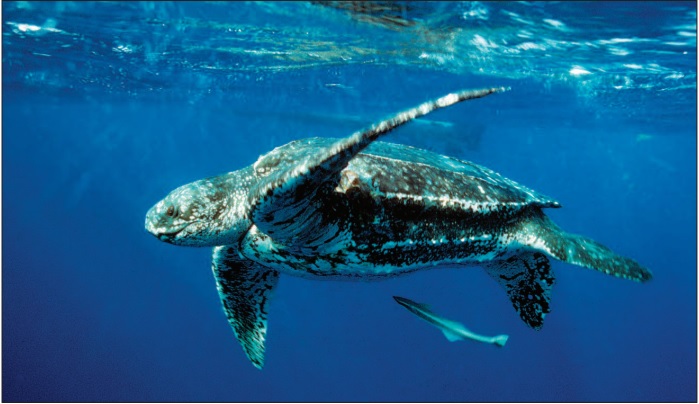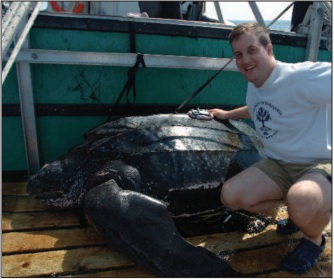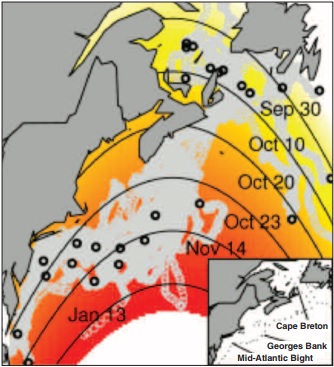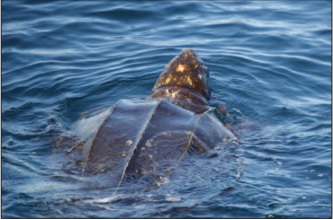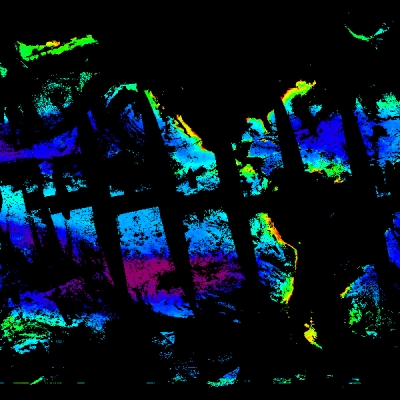When biologist Michael James captured and tagged his first leatherback sea turtle off the eastern coast of Canada in 1999, he was pursuing a mysterious animal. No one knew why Atlantic leatherbacks appeared in the frigid northern waters each year. In fact, researchers knew little at all about leatherbacks, except that they were endangered.
“This animal was, and remains, an enigma,” James said. “Although fishermen had known for a long time that leatherbacks had been sighted off Canadian coasts, these were considered incidental reports.” James, then a graduate student at Dalhousie University in Nova Scotia, Canada, had begun studying leatherbacks with one satellite-linked transmitter attached to a turtle. Long thought to be tropical creatures, the records that James and his colleagues collected suggested otherwise: leatherbacks spent up to five months foraging in Canadian waters before migrating south. Now, more than ten years later, James has tracked over sixty turtles by satellite. Tagging and tracking leatherbacks exposed their behavior and yielded new insights about leatherback biology. But James didn’t yet know what triggered their movements. To discover the answer, he and his colleagues turned to environmental satellite data.
Turtles at risk
During migration, leatherbacks travel the open ocean in relative safety. But between migrations, they spend several months foraging along the continental shelves. “When leatherbacks concentrate in these coastal feeding or breeding areas, they’re most at risk because these are also the environments where fishing activity is most concentrated,” James said.
This overlap between turtle habitat and commercial fisheries poses a problem for leatherbacks. In near-shore waters, the turtles are more likely to become entangled in nets or the vertical lines associated with fishing gear. Leatherbacks are the largest species of sea turtle, growing more than 2 meters (7 feet) long, and weighing up to 650 kilograms (1,400 pounds). When captured in the large, conical nets used in trawl fishing, they are often too large to be released from common turtle excluder devices, and are unable to swim backward to escape.
By studying how turtles use coastal foraging areas, and observing when they migrate to and from them, James hoped to glean information that may help ensure turtle safety and promote less harmful fishing practices.
Migration clues
Each year, James conducted summer fieldwork off the coast of Nova Scotia, capturing and equipping turtles with tracking devices. Every fall the turtles migrated south, and every summer the turtles returned to northern waters to feed on jellyfish and other gelatinous prey. James was beginning to understand their migration routes, but he did not yet understand the factors influencing when the turtles migrated. “Was there some kind of cue, such as day length or declining water temperature?” James asked. “Was it declining food availability? Could we predict when they were going to leave based on any of these variables?”
Turtle tracking devices relayed location and movement, but to understand potential environmental cues affecting migration, James needed more information. So he worked with Scott Sherrill-Mix, a graduate student at Dalhousie University in Nova Scotia. They studied data from twenty-seven turtles, tracked between 1999 and 2004, and matched turtle locations with environmental satellite data to see if changes in ocean temperature and food supply affected their behavior.
To complement the incomplete ocean temperature records obtained from the turtle tracking devices, Sherrill-Mix obtained sea surface temperature data from the Geostationary Operational Environmental Satellite (GOES) and the Advanced Very High Resolution Radiometer (AVHRR) Oceans Pathfinder instrument, available from NASA's Physical Oceanography Distributed Active Archive Center (PO.DAAC).
Observing leatherback food supply was more difficult than determining sea surface temperature. Sherrill-Mix said, “We were really interested in changes in jellyfish abundance, but there are no counts of jellyfish in the open ocean.” Part of the reason there is little data on jellyfish is because satellite sensors cannot measure jellyfish populations directly. However, satellites can detect a common jellyfish food source, phytoplankton, the microscopic plants that float near the ocean’s surface. Because phytoplankton contain a green pigment called chlorophyll, large concentrations of them can color the ocean green; satellites can observe these changes in ocean color. “We hoped that chlorophyll data would approximate jellyfish concentrations,” Sherrill-Mix said. He used ocean color data from the Moderate Resolution Imaging Spectroradiometer (MODIS) sensor and from the Sea-Viewing Wide Field-of-View Sensor (SeaWiFS), both available from NASA's Ocean Biology DAAC (OB.DAAC).
James said, “We were able to tap into these databases pretty quickly and grab values relative to each turtle’s position. I want to stress the value of making the environmental data free, and making it available on the Web. The continuity is really important for projects like ours.”
Modeling turtle timing
Individual leatherbacks began their southward migration over a four-month span, ranging from September 8 to January 13. Sherrill-Mix combined the turtle departure dates they had observed with remotely sensed temperature and chlorophyll data, adding day length, water depth, and turtle gender and size to generate a model. The scientists hoped the model would reveal which of these factors prompted migration, and they initially focused on decreasing food supply and water temperatures. But the model results suggested that the turtles did not leave for the reasons they expected. The largest factor in migration timing turned out to be turtle location.
The leatherbacks in their study tended to congregate in two locations: one group foraged in the waters off Newfoundland and Nova Scotia, and the other group foraged off the northeastern coast of the United States. “We thought that cold water might trigger turtle migration,” Sherrill-Mix said. “But the northern-most turtles left sooner from warmer water. And we thought the same with chlorophyll. We figured that green water would have lots of food for them. But they left earlier from waters rich in chlorophyll.” Sherrill-Mix and James also noticed that once the northern turtles began migrating, they did not stop to forage in the southern location. Sherrill-Mix said, “The northern turtles swim right past where the southern turtles are foraging. If they needed more food, they could easily stop and eat.”
How could the researchers explain the unexpected results? The difference in migration distance between the northern and southern turtles was only 500 kilometers (300 miles). Leatherbacks could cover that distance in about ten days, so distance alone could not account for the wide range of departure dates. Sherrill-Mix and James thought one possible explanation was that jellyfish might have more extreme blooms in warmer, prey-filled waters. Sherrill-Mix said, “Increased prey and temperature speed up the jellyfish life cycle. Since jellyfish die off after mating, this may mean that warm, chlorophyll-rich waters provide a more condensed jellyfish season for the turtles.” The researchers theorized that seasonal jellyfish die-offs occurred earlier at higher latitudes, prompting turtles in these areas to begin migrating while waters were still warm. By contrast, turtles in the southern comparison group were able to feed on jellyfish later into the season.
While some of the results were unexpected, the study provided new questions for James and Sherrill-Mix to explore. They were the first scientists to model and investigate potential migration cues and timing in leatherbacks, which required broader investigation into how seemingly unrelated factors, such as jellyfish life cycles, might influence turtle behavior.
“This work relates fundamentally to the leatherback’s status as an endangered species,” James said. “We need a context in which to look at leatherback behavior and discover what we can do to help them recover.” Knowing when leatherbacks leave or return to an area may aid conservation regulations and promote changes in fishing practices, particularly in near-shore environments where turtles forage and are most at risk. James collaborated extensively with fishermen, and is mindful that simple solutions, such as closing off entire areas, are not always the answer. Having detailed information about turtle migration and behavior can lead to flexible conservation measures that protect both leatherbacks and local fishing industries. “We want to predict leatherback behavior and ultimately, we want fisheries and turtles to co-exist,” James said.
References
James, M. C., C. A. Ottensmeyer, and R. A. Myers. 2005. Identification of high-use habitat and threats to leatherback sea turtles in northern waters: new directions for conservation. Ecology Letters 8: 195−201, doi:10.1111/j.1461-0248.2004.00710.x.
Sherrill-Mix, S., M. C. James, and R. A. Myers. 2007. Migration cues and timing in leatherback sea turtles. Behavioral Ecology , doi:10.1093/beheco/arm104.
For more information
NASA Ocean Biology Distributed Active Archive Center (OB.DAAC)
NASA Physical Oceanography DAAC (PO.DAAC)
Moderate Resolution Imaging Spectroradiometer (MODIS)
Sea-Viewing Wide Field-of-View Sensor (SeaWiFS)
| About the remote sensing data | ||||
|---|---|---|---|---|
| Satellites | Geostationary Operational Environmental Satellite (GOES) | NOAA Polar Orbiting Satellites | GeoEye SeaStar, Aqua | Aqua, GeoEye SeaStar |
| Sensors | GOES I-M Imager | Advanced Very High Resolution Radiometer (AVHRR) | Sea-Viewing Wide Field-of-View Sensor (SeaWiFS) and Moderate Resolution Imaging Spectroradiometer (MODIS) | MODIS, SeaWiFS |
| Data sets | GOES L3 6km Near Real-Time SST | AVHRR Pathfinder SST v5 | OC3 and OC4 chlorophyll a concentration | Aqua MODIS merged chlorophyll product (with SeaWiFS) |
| Resolution | 6 kilometer | 4 kilometer | 9 kilometer | 9 kilometer |
| Parameters | Sea surface temperature | Sea surface temperature | Chlorophyll a concentration | Chlorophyll a concentration |
| DAAC | NASA Physical Oceanography Distributed Active Archive Center (PO.DAAC) | NASA PO.DAAC | NASA Ocean Biology Distributed Active Archive Center (OB.DAAC) | NASA OB.DAAC |
